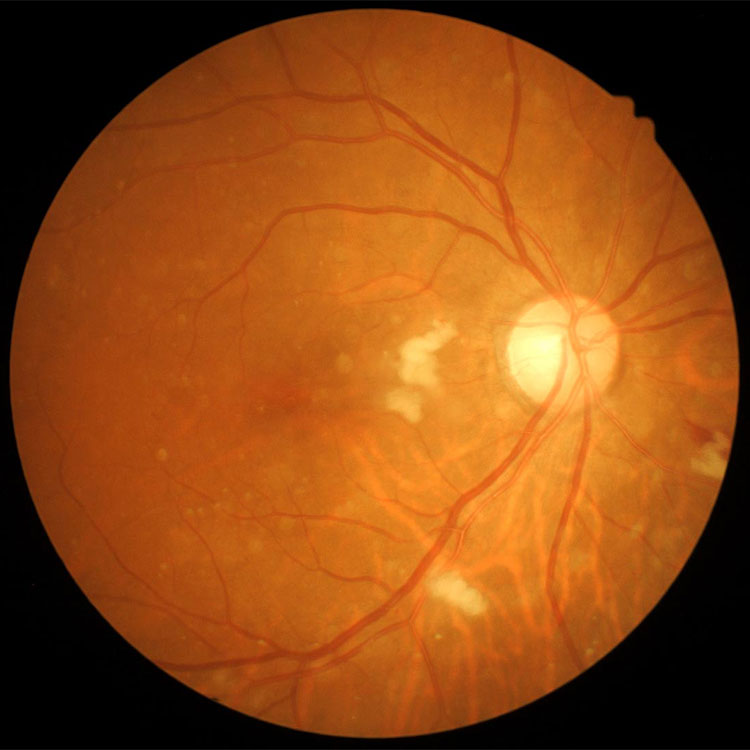Al Ruíz, a Dallas accountant, considered himself lucky to have perfect eyesight. While most of his co-workers wore eyeglasses or contact lenses, he was proud to have never had a vision problem. In fact, he hadn’t seen an eye care professional in several years. So, he became worried when, during his drive home from work, signs along the highway began to blur. Reluctantly, he decided that it was time to have his eyes checked.
Al sat in stunned silence in the office of Dr. Jordan, his optometrist, a few weeks later. After a thorough eye exam, Al learned that he suffered from an eye disease called diabetic retinopathy. According to the doctor, he was also diabetic. Diabetes is a growing epidemic that carries the risk of glaucoma, cataracts and the most common diabetic eye disease, retinopathy. Untreated diabetes can lead to complete vision loss, many times without warning symptoms. Yet nearly one-quarter of the 23.6 million Americans over age 20 who have diabetes are unaware that they have the disease (CDC).
Al was lucky after all: He experienced symptoms, which led him to prompt treatment and the prevention of significant vision loss.
How diabetes affects the eyes
Prevent Blindness America has designated November as Diabetic Eye Disease Month to warn Americans of the potentially blinding effects of diabetic retinopathy. This disease is the leading cause of new blindness cases among adults aged 20-74 (Diabetes Journals). Up to 24,000 Americans are blinded by diabetic retinopathy each year. The American Optometric Association predicts that by 2050, the number of Americans over 40 years old with diabetic retinopathy will triple to 16 million (NIH).
Diabetes is a metabolic disorder in which the body does not produce or properly use insulin, a hormone that allows the body to use blood sugar for energy. It is characterized by high levels of blood sugar, which can cause changes in the blood vessels of the retina, the light-sensitive tissue at the back of the eye that is necessary for good vision.
In the early stages of diabetic retinopathy, small blood vessels in the eye can cause swell in the retina. As the disease progresses, some vessels that nourish the retina are further damaged. The retina will not receive adequate oxygen and nutrients needed to keep the eye healthy. As a result, abnormal new blood vessels may begin to grow on the surface of the retina to replace these damaged vessels. The new vessels, however, have thin, fragile walls. If they leak blood, severe vision loss and even blindness can result.
Testing is essential
Diabetic retinopathy can be diagnosed through a comprehensive eye exam. The first signs of diabetes may be seen in an optometrist or ophthalmologist’s office when retinopathy is discovered. When Dr. Jordan saw bleeding in the back of Al’s eyes during his exam, she referred him for a follow-up test called a fluorescein angiogram. During the procedure, dye is injected into the patient’s arm to allow the doctor to see a detailed image of the eye’s blood vessels. For individuals with diabetes in the United States, Al learned that he was one of the 40 to 45 percent of diabetics who already have some degree of retinopathy at the time of their diabetes diagnosis (NIH).
Who is at risk?
All people with diabetes, including those with Type I (juvenile onset) and Type II (adult onset), are at risk of developing diabetic retinopathy. The longer you have diabetes, the more likely you are to develop it. There is a genetic component to this disease, as well. If your grandmother had diabetic retinopathy, for example, your risk is higher.
Ethnicity is also a significant risk factor. Al Ruíz learned that Mexican Americans and non-Hispanic African Americans are almost twice as likely to develop diabetic retinopathy as non- Hispanic Caucasians.
Diabetic retinopathy can begin without any warning symptoms, which makes a yearly comprehensive eye exam even more critical for diabetics. Pregnant women with diabetes should have a comprehensive eye exam during their first trimester and follow the advice of their eye care professional regarding follow-up visits throughout pregnancy
Vision-saving treatments
To prevent vision loss, early diagnosis and aggressive treatment of diabetic retinopathy are essential. The risk of blindness can be reduced by 90% with timely treatment and follow- up care. In severe stages of diabetic retinopathy, vision may be permanently lost.
Treatment depends on the stage at which the disease is being treated. During the very early stages of the disease, no treatment may be needed. As the disease advances, the following treatment options are available:
Laser surgery. Laser surgery (pan-retinal photocoagulation) has been successful in sealing blood vessels to stop them from leaking, and in shrinking abnormal vessels. Generally, laser surgery is used to stabilize vision, not necessarily to improve it. Al received treatment early enough that only minimal vision loss had occurred.
Intraocular injection. Anti-VEGF medication injected into the eye may help reduce the amount of fluid leaking into the retina. It may need to be repeated or combined with laser therapy to achieve a lasting effect.
Be proactive about your health
Prevention is the key to saving sight that might be lost due to late diagnosis.
Protect yourself against Type II diabetes by maintaining a healthy weight, exercising regularly and eating a low-fat diet.
It is also important to have your blood glucose level tested regularly to determine if you are one of the 54 million people between the ages of 40 and 74 who have pre-diabetes, which would put you at risk for developing Type II diabetes (CDC).
If you have diabetes, you can avoid eye problems by controlling your blood sugar and blood pressure levels and by obtaining regular comprehensive eye exams.
No one likes to consider the possibility of developing diabetes or becoming blind from eye disease. When you are proactive about your health, you can protect yourself. All you need is the knowledge that regular, comprehensive eye and physical examinations provide, and the willingness to follow your health care providers’ recommendations.
Make an appointment with your eye care provider if you have any of the following symptoms:
- Blurry vision
- Difficulty reading
- Sudden loss of vision in one eye
- Suddenly clearer vision*
- Seeing rings around lights
- Seeing dark spots or flashing lights
Sometimes, one of the earlier visual symptoms in an undiagnosed diabetic is suddenly clearer vision (albeit uncommon). For example, someone wakes up one day and can see without their glasses. Yesterday, they were nearsighted. Today, they have perfect vision, which will then fluctuate with their blood sugar levels over the next hours or days. This dramatic improvement in vision is usually accompanied by extremely high blood sugar readings.

